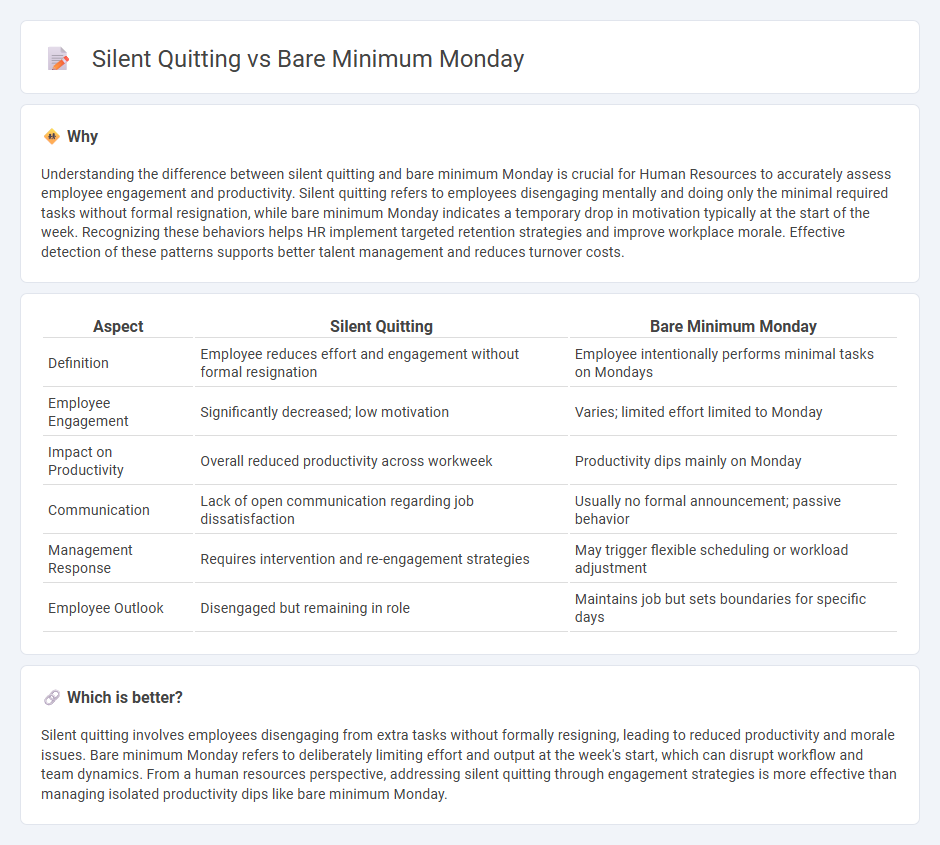
Silent quitting involves employees disengaging from extra work responsibilities without formally resigning, focusing solely on their assigned tasks. Bare minimum Monday refers to a trend where employees exert minimal effort at the start of the workweek, often as a response to burnout or dissatisfaction. Explore how these behaviors impact productivity and workplace dynamics in Human Resources.
Why it is important
Understanding the difference between silent quitting and bare minimum Monday is crucial for Human Resources to accurately assess employee engagement and productivity. Silent quitting refers to employees disengaging mentally and doing only the minimal required tasks without formal resignation, while bare minimum Monday indicates a temporary drop in motivation typically at the start of the week. Recognizing these behaviors helps HR implement targeted retention strategies and improve workplace morale. Effective detection of these patterns supports better talent management and reduces turnover costs.
Comparison Table
| Aspect | Silent Quitting | Bare Minimum Monday |
|---|---|---|
| Definition | Employee reduces effort and engagement without formal resignation | Employee intentionally performs minimal tasks on Mondays |
| Employee Engagement | Significantly decreased; low motivation | Varies; limited effort limited to Monday |
| Impact on Productivity | Overall reduced productivity across workweek | Productivity dips mainly on Monday |
| Communication | Lack of open communication regarding job dissatisfaction | Usually no formal announcement; passive behavior |
| Management Response | Requires intervention and re-engagement strategies | May trigger flexible scheduling or workload adjustment |
| Employee Outlook | Disengaged but remaining in role | Maintains job but sets boundaries for specific days |
Which is better?
Silent quitting involves employees disengaging from extra tasks without formally resigning, leading to reduced productivity and morale issues. Bare minimum Monday refers to deliberately limiting effort and output at the week's start, which can disrupt workflow and team dynamics. From a human resources perspective, addressing silent quitting through engagement strategies is more effective than managing isolated productivity dips like bare minimum Monday.
Connection
Silent quitting and bare minimum Monday are interconnected phenomena reflecting employee disengagement in human resources. Silent quitting describes workers mentally withdrawing without resigning, often leading to minimal effort, particularly apparent on Mondays when motivation dips. This trend challenges HR departments to develop strategies enhancing engagement and fostering a supportive workplace environment to boost productivity.
Key Terms
Employee Engagement
Bare minimum Monday describes employee behavior characterized by minimal effort and disengagement at the start of the workweek, often leading to reduced productivity and morale. Silent quitting involves employees fulfilling only their job descriptions without extra effort or enthusiasm, signaling deeper disengagement and potential retention risks. Explore effective Employee Engagement strategies to transform workplace commitment and drive sustained performance.
Productivity
Bare minimum Monday refers to employees exerting just enough effort to get through the start of the workweek, often resulting in limited productivity and low engagement. Silent quitting involves workers disengaging from extra duties beyond their formal job description, maintaining minimal effort to meet expectations without burnout. Explore deeper strategies to identify and address these productivity challenges in your organization.
Workplace Culture
Bare minimum Monday reflects employees doing just enough to meet basic job requirements, often signaling disengagement within workplace culture. Silent quitting involves employees reducing effort and participation without explicit communication, which can erode team morale and productivity over time. Explore how these behaviors impact organizational success and strategies to cultivate a more engaged workforce.
Source and External Links
What Is Bare Minimum Monday? - Bare Minimum Monday is a workplace trend where employees intentionally do only the minimum required work on Mondays to reduce anxiety and ease the transition from weekend to workweek.
Bare Minimum Mondays - It involves prioritizing self-care, delaying intensive tasks, and condensing essential work into a shorter window to make Mondays less stressful and more manageable.
Bare minimum Monday - Coined in 2022, this practice encourages employees to start the week slowly, focus on self-care, and limit work to only what's necessary to combat burnout and the "Sunday scaries".
 dowidth.com
dowidth.com